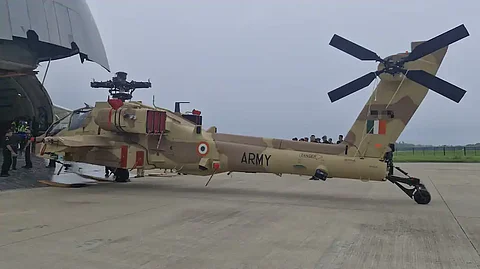
- Home
- Live Blog
- Breaking News
- Top Headlines
- Cities
- NE News
- Sentinel Media
- Sports
- Education
- Jobs

Jodhpur – In a significant boost to India’s combat readiness along its western frontier, the Indian Army has officially inducted the first three of six AH-64E Apache attack helicopters this month, positioning them for frontline operations near the Pakistan border.
Painted in desert camouflage and built in part by a Tata-Boeing joint venture in Hyderabad, these state-of-the-art choppers will be based in Jodhpur, adding formidable teeth to the Army’s rotorcraft fleet, which currently includes indigenous Dhruv Rudra and Prachand helicopters.
What sets the Apache apart is its combination of lethal firepower, advanced technology, and survivability. Armed with a 30 mm M230 chain gun, Hydra 70 rockets, AGM-114 Hellfire anti-tank missiles, and Stinger air-to-air missiles, the Apache is capable of neutralising everything from enemy tanks to helicopters and UAVs — even under heavy battlefield conditions.
Crucially, the Apache is equipped with the AN/APG-78 Longbow radar, mounted above its rotor. This mast-mounted radar can track up to 128 ground targets and prioritise 16 simultaneously, allowing the Apache to stay hidden behind terrain while tracking and attacking with precision.
The chopper’s integration with live drone feeds and networked combat systems gives commanders real-time battlefield awareness.
Its induction comes just weeks after Operation Sindoor, against a backdrop of continued tensions along India’s western border. The Apache's presence introduces a powerful deterrent against enemy armour, terror camps, and logistics infrastructure.
With armoured cockpits, crash-resistant systems, and hardened rotor blades, the Apache is built to survive and strike back. For India’s military planners, this helicopter doesn't just add firepower — it reshapes the battlefield.